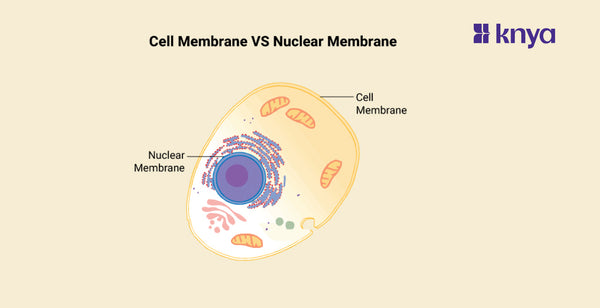Difference Between Cell Membrane and Nuclear Membrane: Despite being selective barriers, the cell and nuclear membranes manage material flow in fundamentally distinct ways. The cell membrane is a single phospholipid bilayer that covers the whole cell and is responsible for communication, transport, and cell shape maintenance. It interacts with the environment by allowing some things to enter easily (such as water and tiny ions) while severely controlling the passage of others. In contrast, the nuclear membrane, a double phospholipid bilayer that surrounds the nucleus, plays a more important function in genetic protection. It rigorously regulates the interchange of materials between the nucleus, which contains the DNA, and the cytoplasm, which comprises the remainder of the cell. This selective exchange occurs via specialised structures called nuclear pores, which meticulously regulate the passage of molecules like proteins and RNA.
Difference Between Cell Membrane and Nuclear Membrane
The cell membrane (plasma membrane) and the nuclear membrane (nuclear envelope) are two essential components of eukaryotic cells, each with distinct functions. Highlighting the differences between them:
|
Feature |
Cell Membrane |
Nuclear Membrane |
|
Location |
Surrounds the entire cell, separating it from the environment |
Surrounds the nucleus, separating it from the cytoplasm |
|
Composition |
Phospholipid bilayer embedded with proteins |
Two phospholipid bilayers with nuclear pores |
|
Permeability |
Semi-permeable, selectively allows passage of substances |
Highly regulated, controls movement of molecules |
|
Function |
Regulates passage of substances, maintains cell shape |
Separates nucleus, regulates molecular passage, provides support |
|
Structure |
Uniform throughout the cell |
Inner and outer membranes with nuclear pores |
|
Organelle Presence |
Contains membrane-bound organelles |
Encompasses nucleus, not associated with other organelles |
|
Role in Cell Div. |
Does not participate directly in cell division |
Breaks down and reforms during mitosis |
|
Pore Size |
Does not contain significant pores |
Contains nuclear pores for molecular passage |
|
Genetic Material |
Does not contain genetic material |
Surrounds nucleus where genetic material is stored |
|
Association with Chromatin |
Not associated with chromatin (DNA) |
Chromatin is found inside the nucleus, attached to the inner membrane |
Order the Best Jogger Scrub from Here!
What is Cell Membrane?
The cell membrane is the outermost layer of a cell, found in both animal and plant cells. It's like a protective fence that controls what enters and leaves the cell. Made up of a phospholipid bilayer (two layers of fat molecules), it's selectively permeable, allowing only certain substances to pass through.
Browse Best Scrubs Collection
Key Features of Cell Membrane:
- This phospholipid bilayer functions as a gatekeeper, determining what enters and leaves the cell. It allows needed nutrients in while excluding harmful elements. Consider it a smart door that controls who enters and exits the residence.
- Proteins anchored in the membrane serve a variety of functions, including communicating with neighbouring cells and transporting chemicals. Consider these proteins to be specialised doorknobs, channels, and sensors that serve a variety of tasks.
- The membrane, like a house's walls, shapes and stabilises the cell.
- Unique molecules on the cell membrane enable cells to recognise one another, much like a home has an address for identification.
What is a Nuclear Membrane?
The nuclear membrane is a double-layered membrane that surrounds the nucleus, the cell's control center. It separates the genetic material (DNA) in the nucleus from the cytoplasm (the rest of the cell's interior). This membrane also has tiny holes called nuclear pores that allow certain materials to move between the nucleus and cytoplasm.
Explore All Women's Scrub
Key Features of Nuclear Membrane:
- Unlike the cell membrane, which has just one layer, the nuclear membrane has two lipid bilayers, adding an extra degree of security to the cell's genetic material. Imagine a residence surrounded by a high-security fence.
- These specialised channels control the movement of molecules between the nucleus and the cytoplasm. Consider them as regulated fence gates that let important components like RNA and proteins enter and depart the "nuclear house."
- The nuclear membrane serves to organise the cell's DNA within the nucleus. Consider constructing file drawers within the home to protect the genetics
- The membrane interacts with proteins to regulate gene expression, determining which genes are switched on and off at any particular time. This resembles a control panel within the house that decides which rooms (genes) are active.
Shop Best Lab Coats from Here!
Similarities Between Cell Membrane and Nuclear Membrane
- The cell membrane and the nuclear membrane are mostly made up of phospholipids.
- Both act as barriers, controlling the flow of substances into and out of the compartments they encompass.
- Both membranes have selective permeability, which allows only specific molecules to flow through.
- Both membranes are dynamic structures, meaning they may alter composition and permeability in response to cellular impulses.
- Both membranes include integral proteins that participate in a variety of cellular activities, including transport and signalling.
- The cell's efficient functioning and survival require both membranes.
While both the cell membrane and the nuclear membrane are necessary for cell activity, there are significant variations between them. The cell membrane, a single lipid bilayer, constitutes the cell's outermost barrier and regulates what enters and leaves. In contrast, the nuclear membrane, a double lipid bilayer, surrounds the nucleus and protects the genetic material (DNA) from the cytoplasm. Furthermore, the nuclear membrane has specialised pores for selective transport, whereas the cell membrane uses a variety of processes for material exchange. This distinction emphasises their separate roles: the cell membrane controls communication with the environment, whereas the nuclear membrane protects and regulates access to the cell's genetic code.
| Check out More Articles | |
| Difference Between Cartilage And Bone | |
| Difference Between Endocrine And Exocrine Glands | |
| Difference Between Cell Wall And Cell Membrane | |















